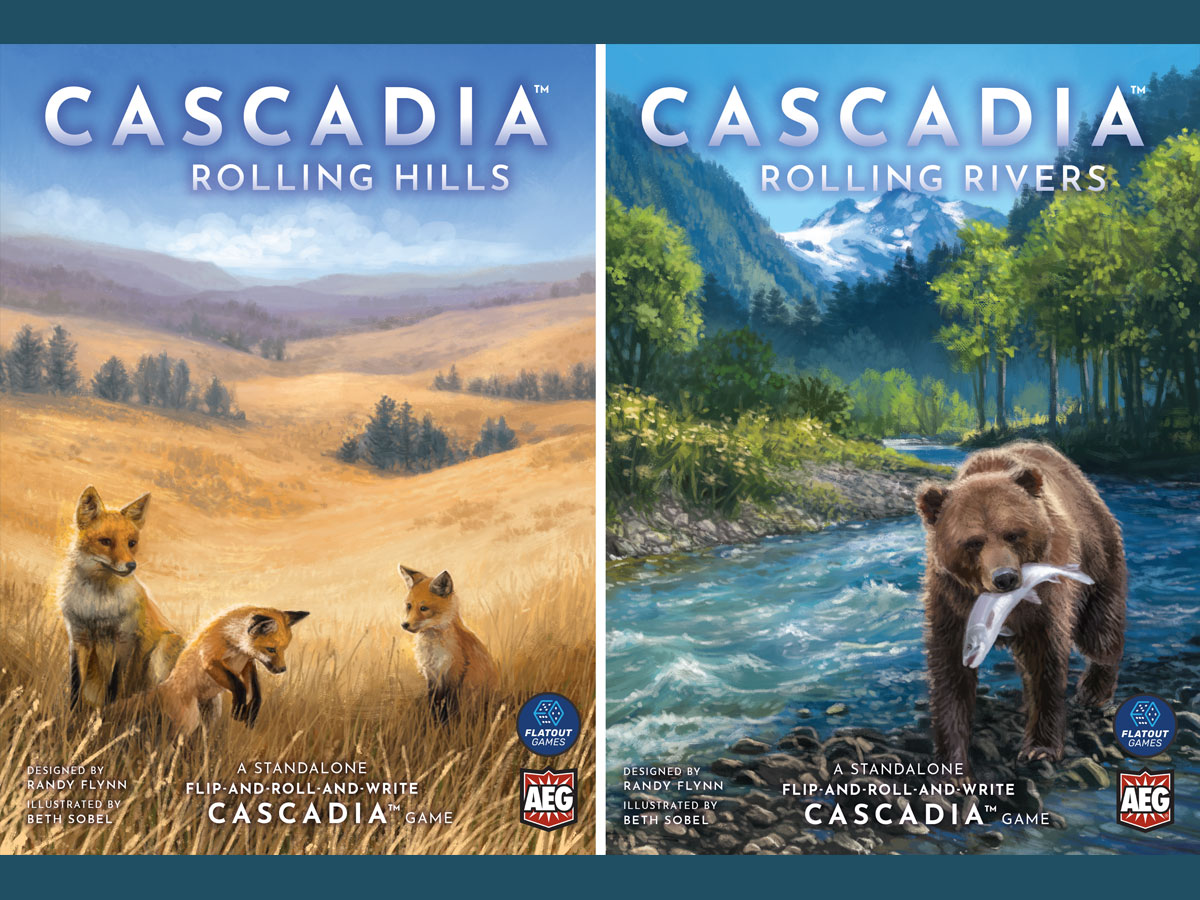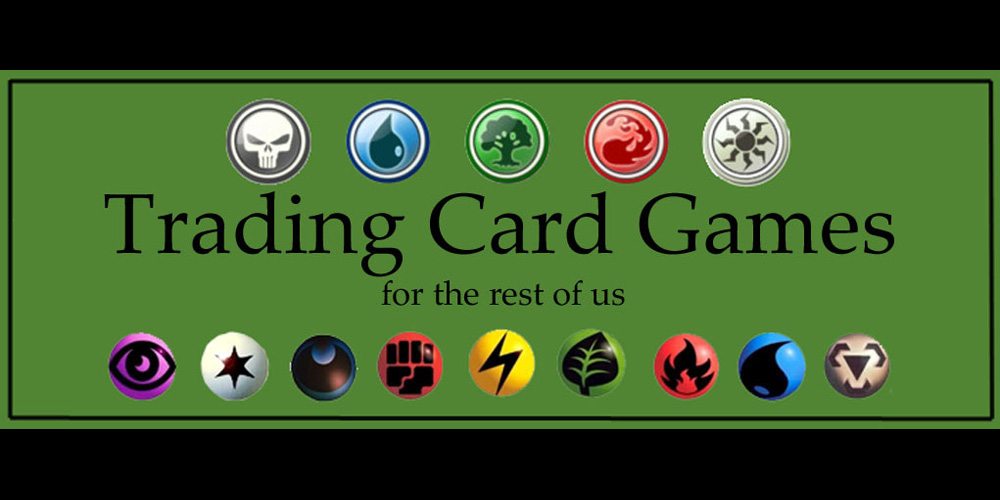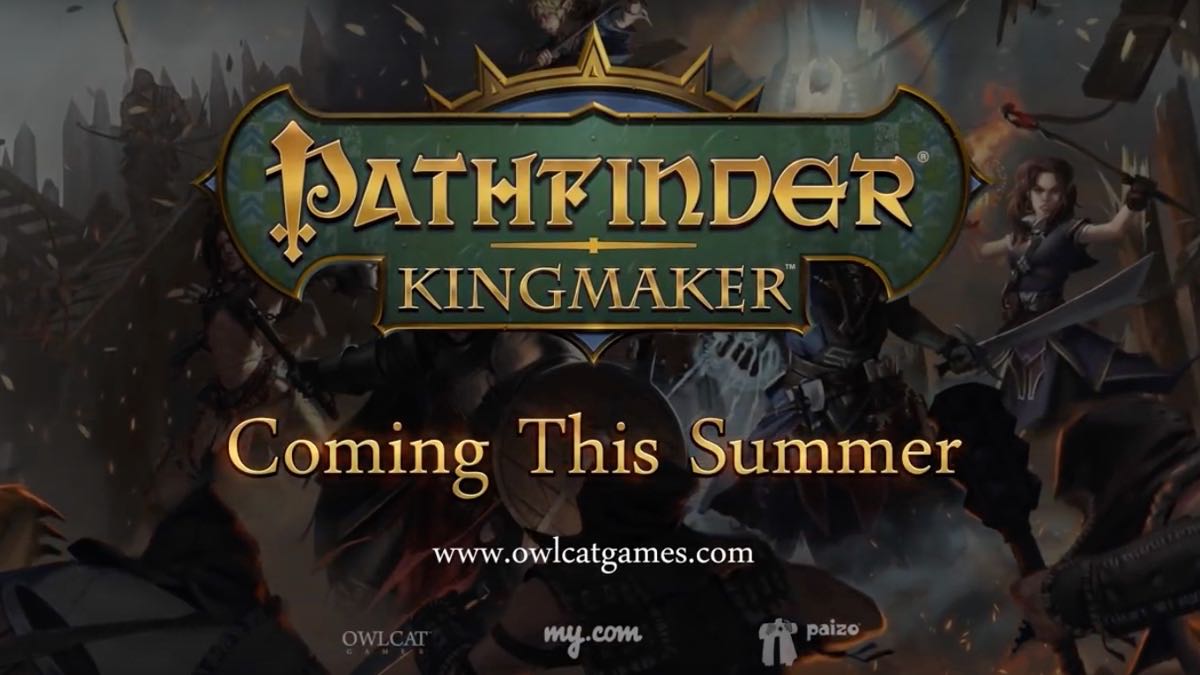The award-winning game of building habitats and attracting wildlife in the Pacific Northwest now comes in a new form: a flip-and-roll-and-write!
What Is Cascadia: Rolling?
Cascadia: Rolling is a series of flip-and-roll-and-write games for 1 to 4 players, ages 10 and up, and takes about 15 to 30 minutes to play. There are two flavors: Rolling Hills and Rolling Rivers. They’re currently seeking funding on Kickstarter, with a pledge level of $19 for one game or $35 for both games. Although they are based on the Cascadia tile-laying game, you don’t need to own (or have played) Cascadia to enjoy these. Each of the Cascadia: Rolling titles has 4 types of scoresheets of varying degrees of complexity; I think 10 and up is appropriate for the easier sheets, but the more complex sheets could be a challenge for younger kids or less experienced adults.
Cascadia: Rolling was designed by Randy Flynn and published by Flatout Games, with illustrations by Beth Sobel.
New to Kickstarter? Check out our crowdfunding primer.

Cascadia: Rolling Components
Note: My review is based on a prototype copy, so it is subject to change and may not reflect final component quality; what you see here should be pretty close to the finished version, though the printing on the dice will be improved.
Here’s what comes in the box:
- 3 Central dice
- 1 Special Central die
- 8 Personal dice (2 per player)
- 30 Habitat cards
- 4 Beginner Completion cards
- 8 Advanced Completion cards
- 64 Double-sided Environment sheets (16 each of 4 types)
- 64 Double-sided Tally sheets
- 4 Player Aid cards
Kickstarter backers will also receive a mini-expansion of objective cards in each set.
The two versions of Cascadia: Rolling have the same list of components, but most of the components are specific to each version. The only components that are the same between the two sets are the 3 central dice (there are two types, but both sets have the same two types) and the personal dice—no matter which version you’re playing, you will have two particular personal dice. If you have both games, this also allows for combining the two sets to play with up to 8 players, and it also means you can mix and match habitat cards and completion cards, or use the special central die from either set to give some different abilities.
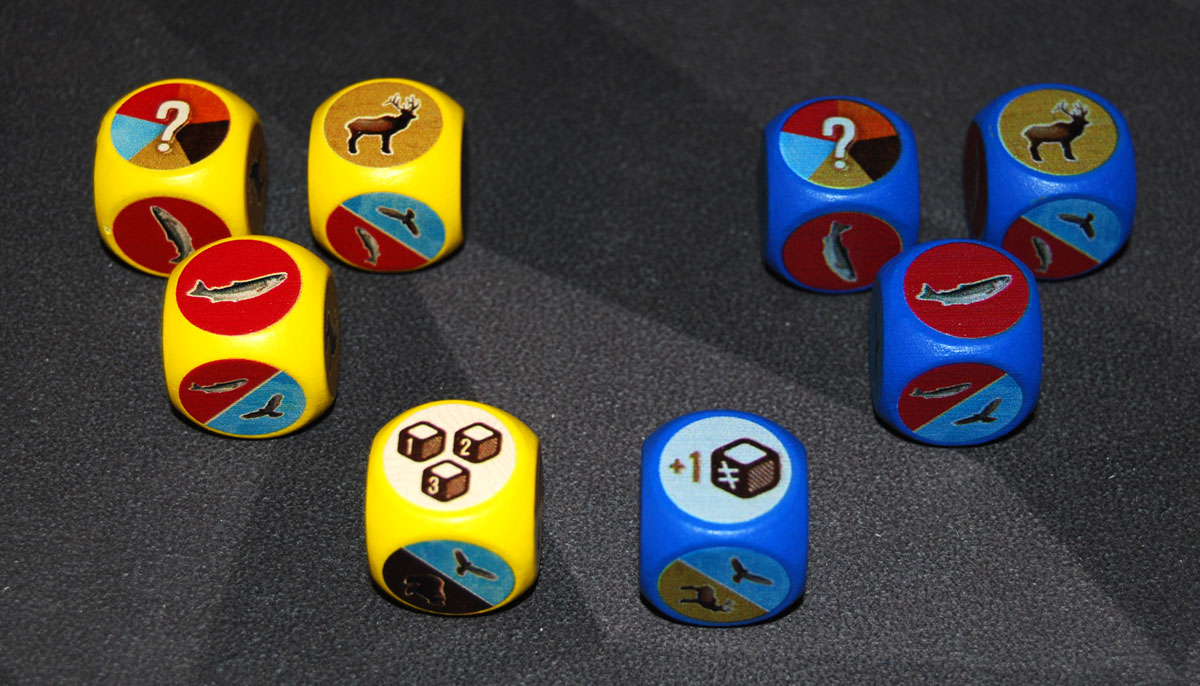
All of the dice are custom wooden dice; the central dice are larger with a base color (yellow for Hills and blue for Rivers but they have the same faces) and the personal dice are smaller. Most of the faces of all of the dice show wildlife, or the wild icon that represents any animal. The exception is the special central die, which has three faces that show wildlife (including some combinations not present on the other dice) and three faces showing special effects.
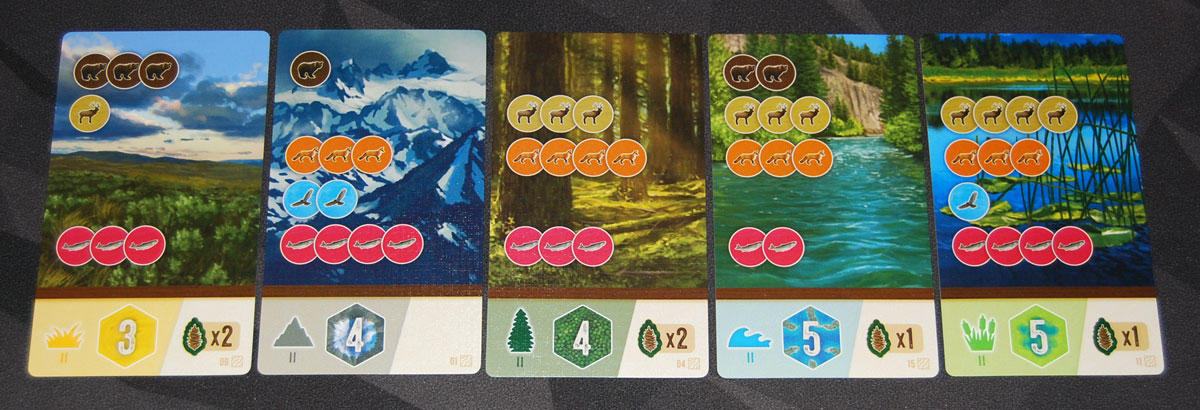
The habitat cards are oversized cards—they come in two tiers and in five different terrain types. The front of the card has a background illustration of the habitat, and then a number of icons for which animals are required to complete that habitat. Each one also has the rewards for completing it—a number from 1 to 5, as well as potentially some pine cones. The completion cards are small cards, sized so that they can be placed above or below the habitat cards.
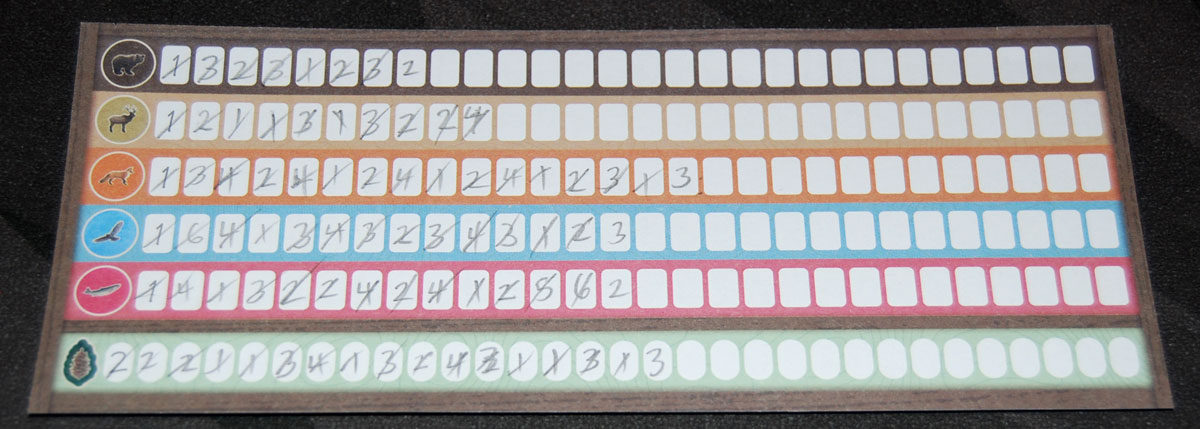
The tally sheets are pretty simple: one row for each of the five animals, and a row for pine cones. You just write in your current total for each row, and as you gain or spend them you cross it out and write the new total in the next box. The environment sheets have a bit more going on, but each one has various hexes representing the different terrain types, along with a lot of other stuff. There are four sheets labeled A through D, and you can see at a glance that they get more and more complex as you go. They do share iconography, and each one has a scoring section down the right side so you can see at a glance what things you’ll score points for. Each sheet type is also named after an actual habitat in the Pacific Northwest, with a little bit of flavor text describing it.
How to Play Cascadia: Rolling
You can download the rulebooks here.
The Goal
The goal of the game is to score the most points by building the most harmonious ecosystem.
Setup
Give each player a tally sheet, an environment sheet, and two personal dice. (Note that there are two different personal dice and everyone should have one of each.)
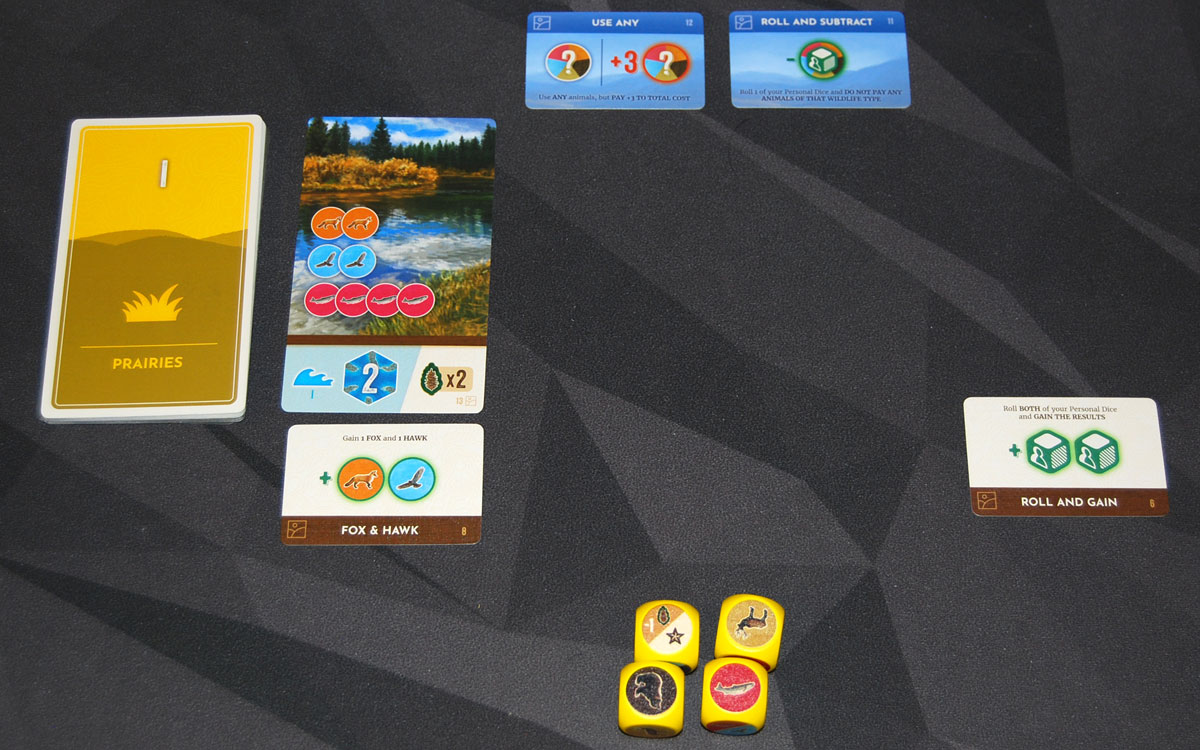
Set up the habitat deck: take 2 of each habitat from Tier 1, and 2 of each habitat from Tier 2. Shuffle the tiers separately, and stack Tier 1 on top of Tier 2. Reveal the first card, and leave space for three more cards to its right. Then, shuffle the completion cards and reveal four of them—these are placed in the four columns for the habitat cards; the blue discount cards are placed above the row, and the tan bonus cards are placed below the row.
Gameplay
First, everyone rolls their own dice and any player rolls the central dice.
Then, everyone collects wildlife: typically, you choose one animal type, and then you may collect all of that type from the central dice and your own personal dice, but there are some special effects that can modify this.
If the special central die is showing one of the special effect faces, then that can be used. Depending on which set you’re using, you may be able to re-roll dice, choose any 3 dice instead of one animal type, count one of your personal dice twice, and more.
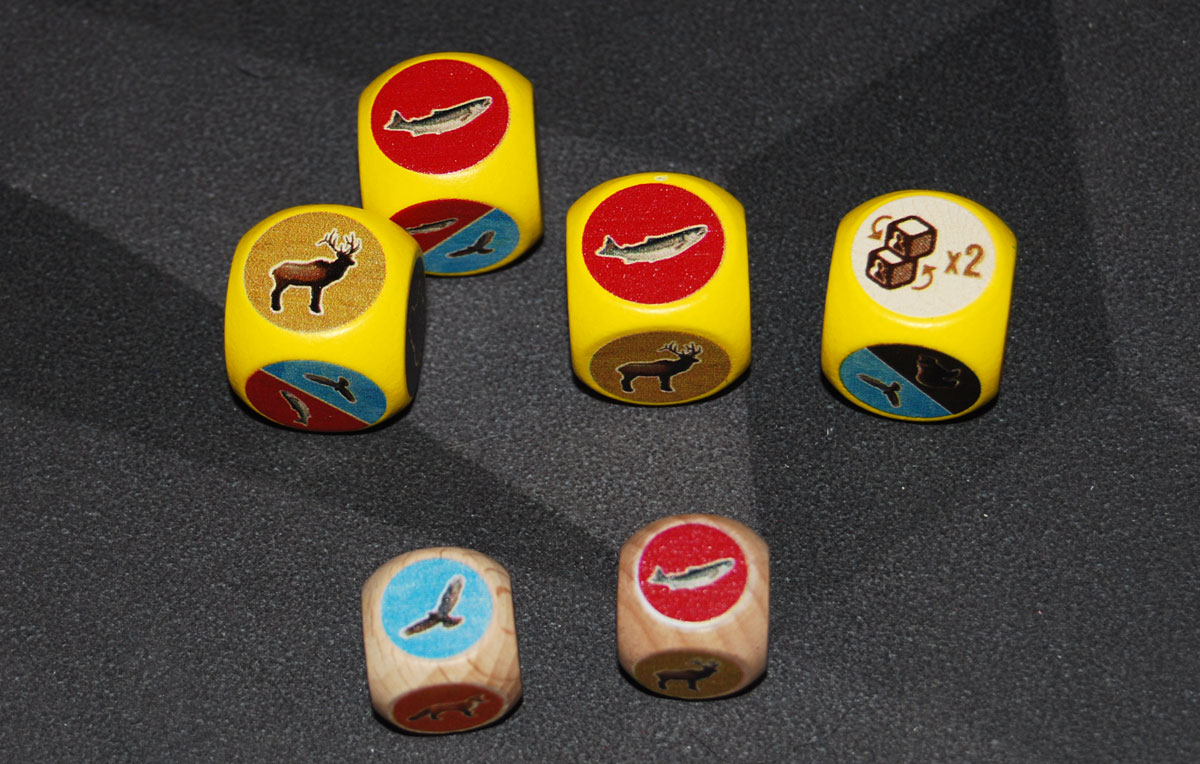
You may also spend pine cones (“nature tokens”) in three different ways, but only once per round:
- Down-convert: spend 1 token to change all of one animal one step lower. (Don’t physically change the dice—just count them as lower.) The animals are ranked from low to high: salmon, hawk, fox, elk, and bear.
- Up-convert: spend 2 tokens to change all of one animal one step higher.
- Take 2 types: spend 3 tokens, and now you can choose 2 different types and take all of them.
Everyone makes their selections simultaneously and updates their tally sheets accordingly.
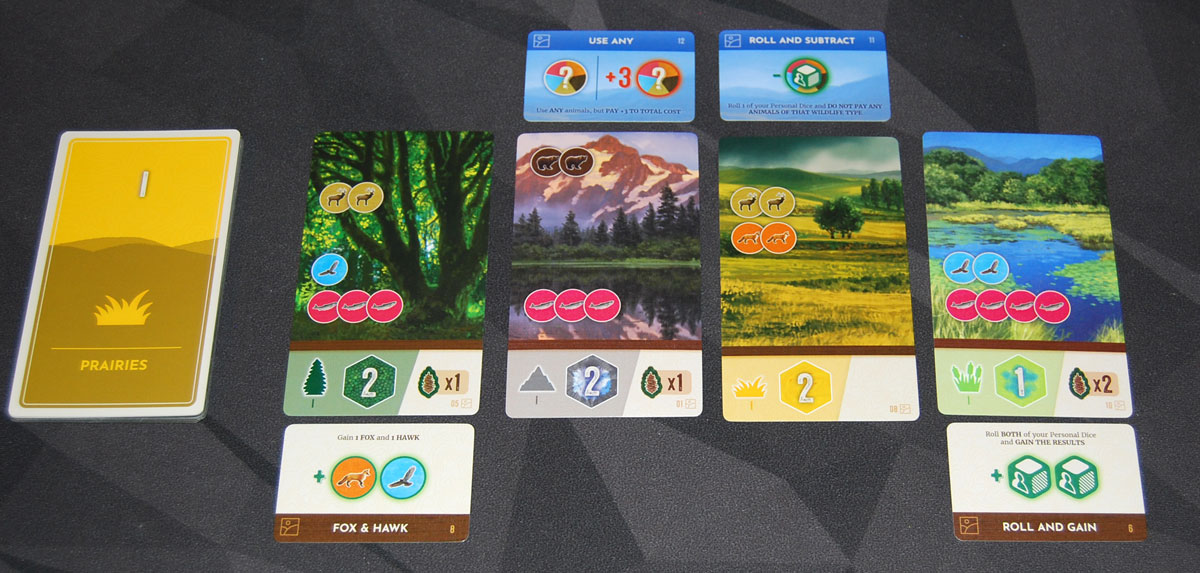
Then, each player may optionally complete a habitat card from the row: spend the animals indicated on the habitat card to complete the card. If it has a discount card above it, you may use that discount. If it has a bonus card below, you get the bonus after spending the animals. You also earn any pine cones as indicated on the habitat card. Each habitat card is one of 5 types, and has a value: each sheet has a different way of marking that value, which I’ll explain in the section below. (Multiple players can complete the same habitat card, and you may also complete the same habitat card again in a later turn.)
Once everyone is done, prepare for the next turn by shifting all the habitat cards one space to the right and drawing a new one. When a card is moved from the fourth space, it is discarded and can no longer be completed.
Game End
The game ends after 20 turns, when the deck has run out, and players will tally up their scores on their sheets. Highest score wins, with ties broken by number of remaining nature tokens.
Environment Sheets
Let’s take a look at how the sheets actually score. Although Rolling Hills and Rolling Rivers have unique sheets, the four ranks of sheets have some similarities.
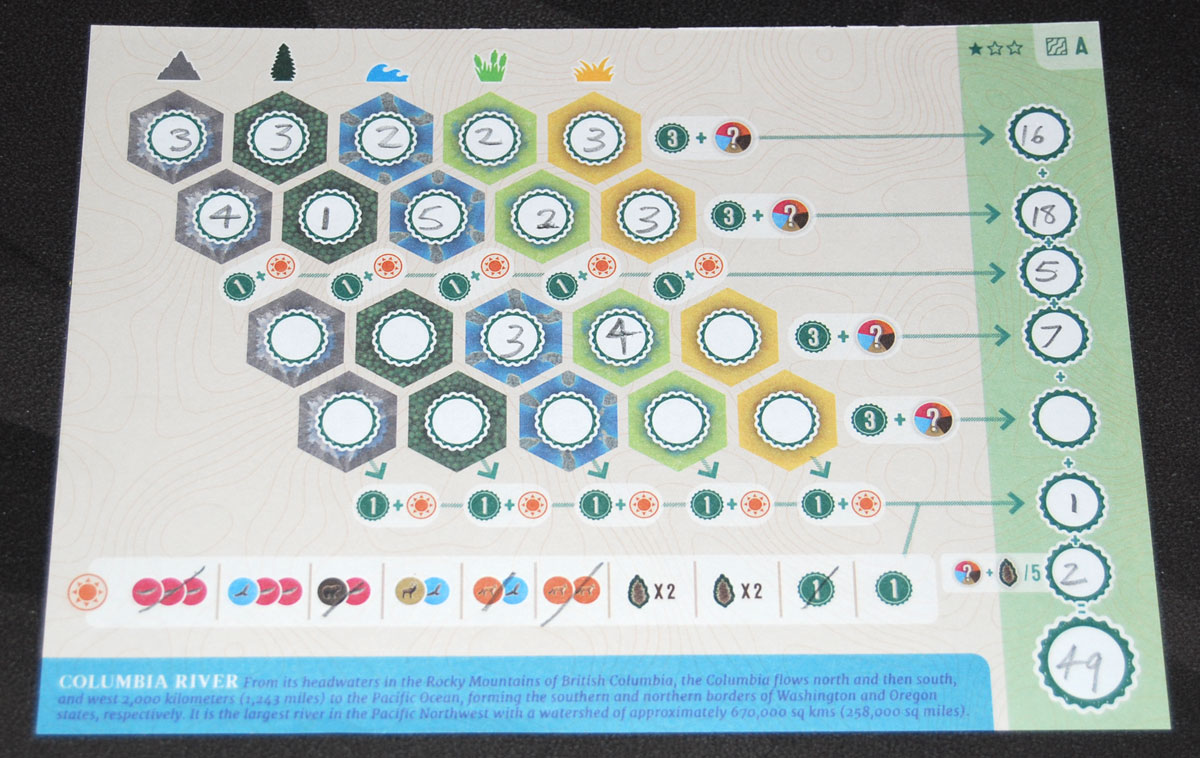
Sheet A is the simplest: it has a grid of hexes: 5 habitat types, 4 of each. Whenever you complete a habitat, you just write in the value of that card in the corresponding column, from top to bottom. You’ll score for the total value in all of your hexes, and you’ll also earn bonuses for completing rows and columns. Some bonuses are points, and some will earn “sun” icons. When you earn a sun icon, you get to choose any of the bonuses shown in the sun row, mark it off, and gain it—these include immediate wildlife or pine cones for your tally sheet.
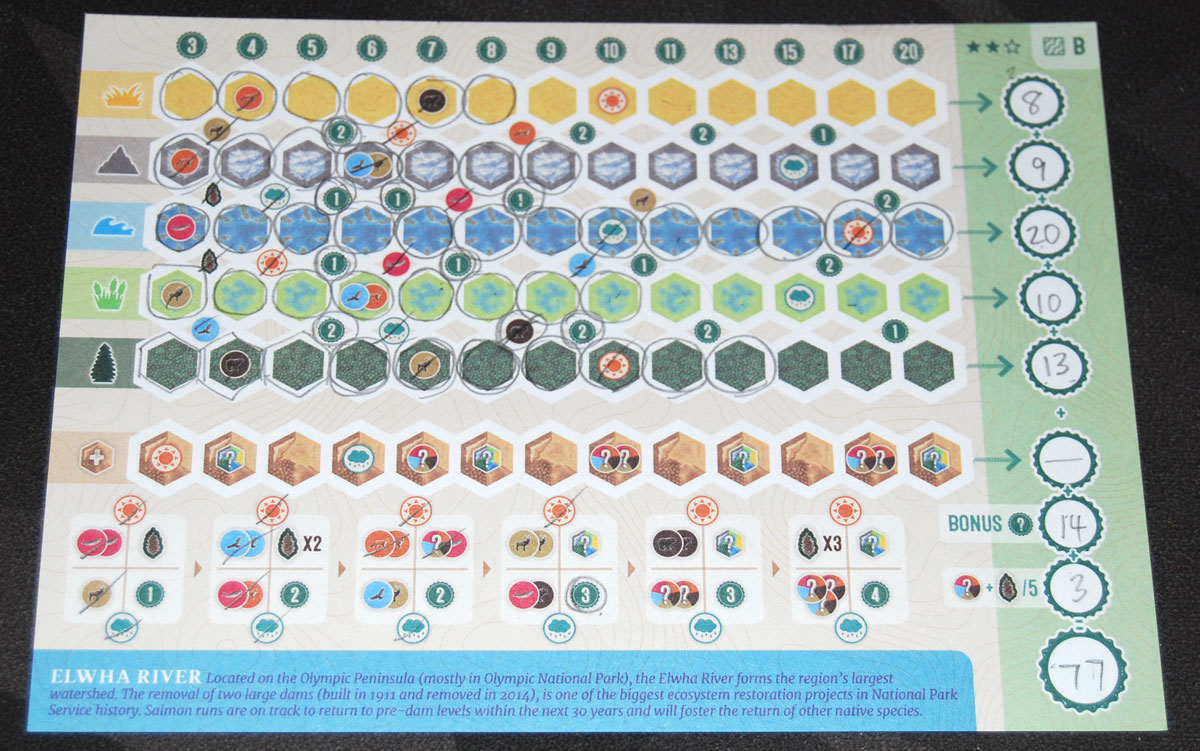
Sheet B is also a grid: this time it has longer rows for each of the habitat types, plus a row for overflow. When you complete a habitat, you circle that many hexes of that type, from left to right. You score bonuses when you circle them, and there are also some bonuses in between the rows that you’ll score if you circle all the surrounding hexes. You’ll score points based on how far you make it in each row (shown at the top above the columns). If you complete an entire row, then any time you would gain more of that habitat, you get to circle hexes in the overflow row. Rolling Hills introduces landmark icons—when you circle one, you mark it off in the little chart, which gives you bonuses for completing rows and columns in that grid. Rolling Rivers has sun and rain bonuses, which give you options from the grids at the bottom.
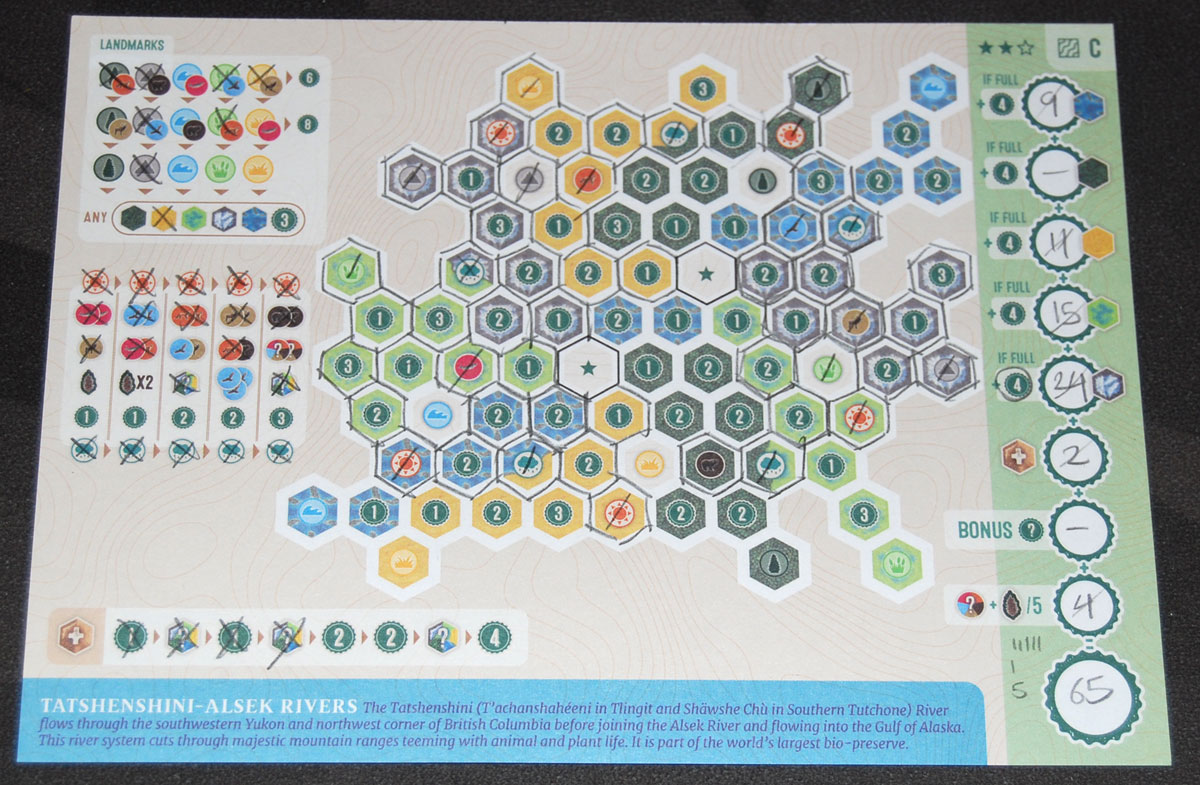
Sheet C starts to look a bit more like the tile-laying version of Cascadia: you see a hex map of various terrains. You’re still circling a number of hexes each time you complete a habitat card, but now you have to start from the stars and circle adjacent hexes, just like you’re laying out tiles to form a contiguous map. Points and other bonuses are scored by circling them, and you score bonus points if you manage to circle all of a particular habitat type.
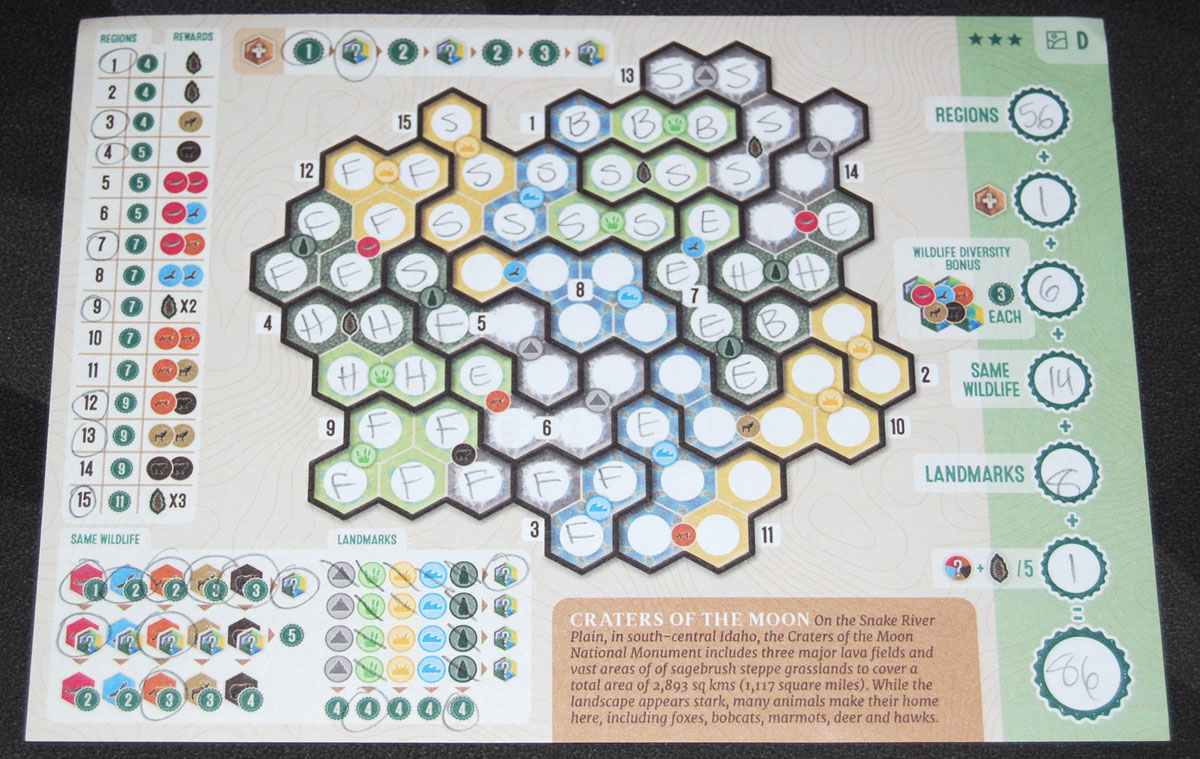
Sheet D is, of course, the most complex. It is still a hex map of various terrains, and now the hexes are blank instead of having points in them. But you don’t write in numbers—instead, you write in animals! When you complete a habitat card, you get to write in that many animals in the corresponding habitat hexes—and the animals you write must be present on the card you completed. (So if the card you completed only has 1 bear in it, you can’t write 2 bears on your sheet.) You can score the various bonuses on the map by surrounding them, and at the end of the game you’ll also earn a wildlife diversity bonus for each habitat type that has all 5 animal types in it. Rolling Hills will give you points when you completely fill in the bold-outlined sections of the map; Rolling Rivers has a chart at the top that indicates patterns for scoring each animal type—these will look familiar to those who have played Cascadia before.
Why You Should Play Cascadia: Rolling
I really love the original Cascadia—I gave it our GeekDad Approved seal, and it was also one of our Game of the Year finalists. It has a great puzzly feel to it, and I also love that it’s so easy to learn but includes more scoring cards so that you can ramp it up when everyone is ready. (And, as is often the case with Flatout Games, it also includes rules for a Family Variant in case you need to simplify it a little for younger players.) The fact that it shows off the natural beauty of the Pacific Northwest is a bonus for me, too. The recent expansion, Landmarks, adds a good degree of complexity to the game for those who want an even more thinky game—watch for a review of that one soon!
Cascadia: Rolling is fascinating to me because it takes the concept of Cascadia and translated it into the roll-and-write format in a way that runs the gamut from the family variant all the way up to Landmarks (and maybe even a bit beyond!). Each of the Cascadia: Rolling titles is really four games in one; although the rolling and collecting wildlife and spending to complete habitat cards is the same, the differences between the sheets are more than just a layout change or a few special effects—they require totally different ways of thinking about them.
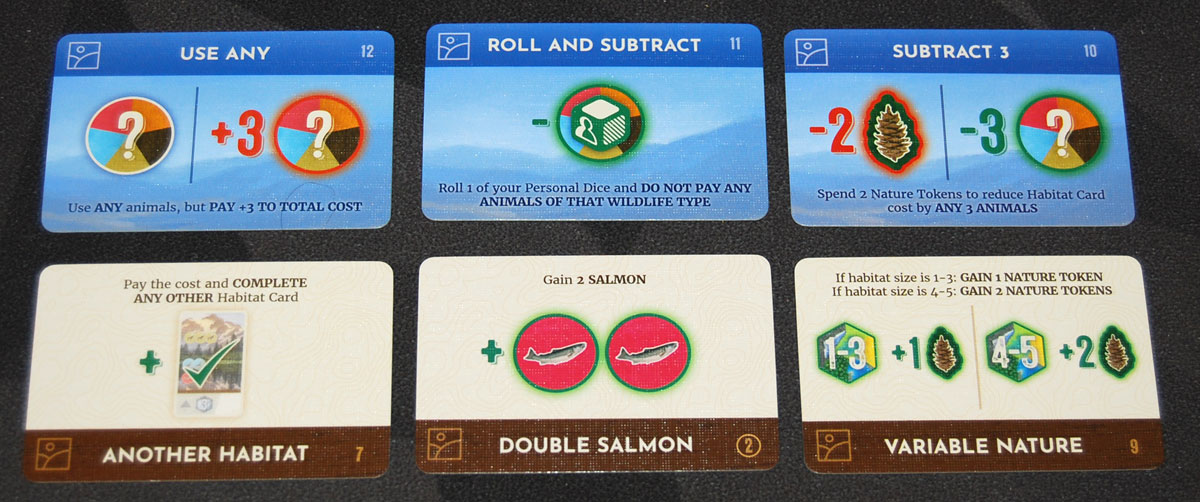
Regardless of which sheet you use, there’s always the decisions about which animals to claim from the dice, and which cards to complete. Since the cards shift every turn like a conveyor belt, there are also important considerations about when to complete a card. Maybe if you complete this mountain now, you can spend pine cones instead of animals, but if you wait until next turn, you’ll gain some bonus wildlife. You also want to make good use of your nature tokens—typically they help you get more animals from the dice, but how many tokens is it worth to get just one more bear? What about three more hawks? Sometimes you get a string of habitat cards that all need foxes so you invest really heavily in trying to get foxes … and then those cards roll off the end of the line and you realize now you need elk instead.
Sheet A is a beginner-level roll-and-write, one that would be good for somebody new to the genre or when you want something you can play without straining your brain too much. It’s fun to roll dice, collect animals, and see how they line up with the habitat cards. Completing the higher value cards is one way to score points, but it means spending more animals … so you might not fill in as many circles. You may have to choose between having fewer high-point circles and being able to complete rows or columns for bonuses. Since there are 20 turns and 20 circles, the only way to fill in your entire sheet is if you never miss a turn, which is really tough!
Sheet B makes you start thinking about adjacency; the 5 habitat types are no longer functionally equivalent, because you’ll earn various bonuses at different times across the row. Do you want to go for an easy salmon bonus, or work toward surrounding those bonus points between the two rows? It also drives you to work on adjacent rows because of those bonuses, rather than just jumping all over the place.
Sheet C starts approaching the tile-laying game with its hex map—you feel more like you’re building out the ecosystem rather than just checking off rows and columns on a chart. If you want a particular bonus, you have to build out a path toward it.
And, finally, there’s Sheet D: it’s a whopper! Although it feels the closest conceptually to Cascadia since you’re putting animals onto the habitat hexes, I think it’s actually a significantly more complex puzzle than the tile-laying version. There’s a lot to keep track of: which animals do you need to arrange on this habitat—and are those even present on the card you can afford to complete? Do you try to go for a diversity bonus by putting lots of different wildlife in a habitat, or do you try to score the bonuses for filling a region with all of the same animal?

But even though Sheet D looks a bit like the tile-laying game, down to the animal scoring charts in the Rolling Rivers version, Cascadia: Rolling is still very much its own game. From the dice and cards to the ways that you build habitats and score points, it provides four different types of puzzles to play around with. If you enjoy roll-and-writes, then I think you’ll enjoy Cascadia: Rolling, particularly sheets C and D for the chain-reaction bonuses. My only concern about the games is whether you’ll run out of sheets! They’re double-sided, so that means you can get 32 individual plays out of any given sheet. But if you combine sets and play an 8-player game, that means only playing 4 times before you run out of that sheet! Hopefully there will be ways to get refills later, because I can see Cascadia: Rolling being a hit.
For more information or to make a pledge, visit the Cascadia: Rolling Kickstarter page!
Click here to see all our tabletop game reviews.
![]() To subscribe to GeekDad’s tabletop gaming coverage, please copy this link and add it to your RSS reader.
To subscribe to GeekDad’s tabletop gaming coverage, please copy this link and add it to your RSS reader.
Disclosure: GeekDad was loaned prototypes of these games for review purposes.
